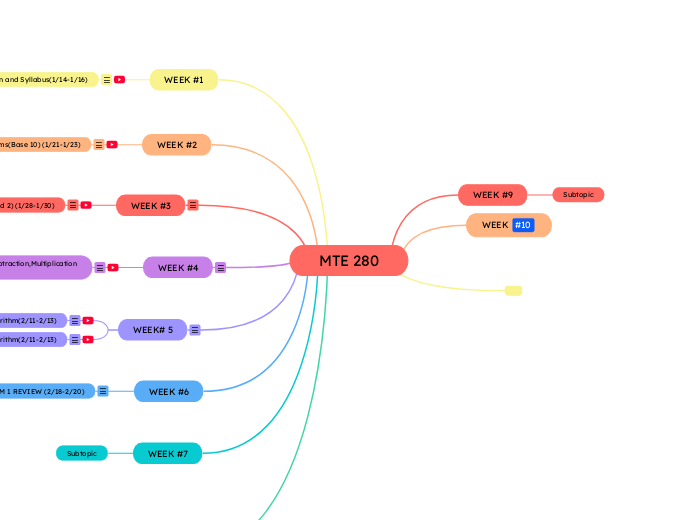MTE 280
WEEK #1
Introduction and Syllabus(1/14-1/16)
Introduction and Syllabus(1/14-1/16)George Pólya Polya’s Four Steps to Problem SolvingUnderstand the problem Devise a planCarry out the planLook back (reflect)Understand the problemWhat is it?Can you draw a picture to help understand the questionDevise a planWhat strategy will you use to figure out the problemTableDraw it outBreak it downCarry out the planAttempt problem with plan chosenIf plan doesn't work, try againLook Back(Reflect)Does your answer make sense? Is it a reasonable one?
WEEK #2
Number Systems(Base 10) (1/21-1/23)
Number Systems(1/21-1/23)Base 10: one to ten relationshipFor example, the number 243 is can be shown like this....2 4 3hundred tens onesEach number gets bigger by ten in each place value going up starting with the ones, however when we get into the decimals the numbers get smaller by ten.The digits used in base 10: 0,1,2,3,4,5,6,7,8,9ones -------> 10^0tens---------> 10^1hundreds ------> 10^2thousands--------> 10^3Expanded Notation375= 300+70+5 (3x100)+(7x10)+(5x1) (3x102)+(7x101)+(5*100)1078= 1000+0+70+8 (1x1000)(0x100)+(7x10)+(5x1) (1x103)+(0x102)+(7x101)+(8*100)
WEEK #3
Whole Number Operations: Understanding Place ValuePlace Value System: Bases 5 (1/28-1/30)
Different Bases(Base 5 and 2) (1/28-1/30)
Different Bases(Base 5 and 2)(1/28-1/30)By learning to convert numbers between base 5 and base 10, students can understand how place value works in any number system. Base 5:ones------> 50fives-------> 51twenty-fives------> 52one hundred twenty five----------> 53Digits used in base 5: 0,1,2,3,4For base 5, making groups of fives using blocks or drawing it out can help students visualize it.10235=(1x53)+(0x52)+(2x51)+(3x50) (1x125)+(0x25)+(2x5)+(3x1) 125+0+10+3 =138345=(3x51)+(4x50) (3x5)+(4x1) 15+4 =19Base 2:ones------> 20two-------> 21fours------> 22eights---------> 23Digits used in base 2: 0,1,2For base 2, making groups of 2 using blocks or drawing it out can help students visualize it.11112=(1x23)+(1x22)+(1x21)+(1x20) (1x8)+(1x4)+(1x2)+(1x1) 8+4+2+1 =15
WEEK #4
Properties(2/4-2/6)AdditionsSubtractionMultiplicationDivison
The Meaning of Addition, Subtraction,Multiplication and Division (2/4-2/6)
The Meaning of Addition, Subtraction,Multiplication and Division(2/4-2/6)Additionmeaning putting together; joining Propertiesa. Identity- adding zero does not change the equation EX: 2+0=2b. Commutative- order of number in equations does not matterEX: 3+7=7+3c. Associative: grouping does not change the answerEX: 7+3+5------->(7+3)+5 OR 7+(3+5)Subtractionmeaningtakeaway Property Comparison- How many of something does someone have?EX: Z has 5 cookies and J has 3 cookies. How many cookies does Z have than J?Missing AddendEX: 3+___=8E gave M 3 cookies. How many more cookies does M have mowMultiplication meaningrepeated additionCartesian product of two sets is the set of all possible ordered pairs that can be made from those setsPropertiesa. Identity- multiplying by one does not change the equationEX: 2x1=2b. Commutative- order of number in equations does not matterEX: 3x7=7x3c. Associative: grouping does not change the answerEX: 7x3x5------->(7x3)x5 OR 7x(3x5)d. Distributive property :multiply each addend by the number outside the parentheses to solve the expressionEX: 3(2 + 2) = 3 × 2 + 3 × 1.DivisionPropertiesa. Division by zero is undefined:Dividing any number by zero is not allowed and results in an undefined answer. EX: 10 / 1 = 10b. Identity property:Dividing any number by 1 gives the same number as the original number. EX: 5 / 5 = 1c. Not commutative:Unlike addition and multiplication, changing the order of numbers in division will not result in the same answer. EX: "10 divided by 2" is 5, but "2 divided by 10" is 0.2,
WEEK# 5
Algorithms(2/11)
Addition and Subtraction Algorithm(2/11-2/13)
Addition and Subtraction AlgorithmAddition Algorithm1.American Standard: 576+2798552. Partial Sum 576+279 1 51 47 8 5 5 3.Place Value 576+279 15(6+9)1 4 0(70+70)7 0 0 (500+200)8 5 5 4.Left to Right 576+2797 0 01 4 0 1 58 5 5 5.Expanded Notation576----------> 500+70+6+ 279------> +200+70+9 855 800+50+56.Lattice Method 5 7 6 +2 7 9 0 1 1 7 4 58 5 5 Subtraction Algorithm1.American Standard576-2792872.Reverse Indian576-2793 92 8 73.Left to Right576-279300200 90 80 72874.Expanded Notation576----------> 500+70+6- 279------> -200+70+9 287 200+80+75.Integrated Subtraction Algorithm576-279 -3-10+300287
Multiplication Algorithm(2/11-2/13)
Multiplication Algorithm1.American Standard: 23X14 92+ 2303222. Partial Sum 23 4x3=12X14 4x20=80322 10x3=30 10X20=200 3223.Expanded Notation23 ------> 20+3X14 ----->10+492 ------->90+2+230------>200+30+0322 300+20+24.Lattice Method-Lattice Method is hard to type out so I link a video explaining the method
WEEK #6
EXAM 1 and EXAM 1 REVIEW (2/18-2/20)
EXAM 1 REVIEW
WEEK #7
Subtopic
WEEK #8
Subtopic
WEEK #9
Subtopic
